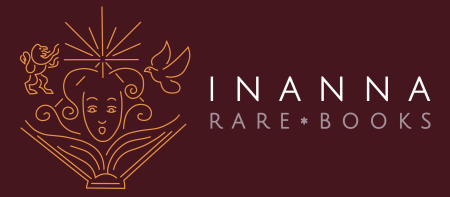Roberts, Site of Cana [Lebanon] of Galilee, April 21st, 1839.
Site of Cana [Lebanon] of Galilee, April 21st, 1839 [″Cana, Vue Generale” – “Cana – General View”].
Original, mid-19th century, vintage Lithograph after the original painting in the Victoria & Albert Museum. [The original Lithograph is shown in the wonderful David Roberts-publication on page 23 and 24 in full colour. The History of the image is explained in full on page 22. The original monograph on David Roberts and his work, accompanies the Lithograph as a gift to any future buyer, showing on 120 colour plates 123 colour-facsimile-illustrations and reproductions from his Journal from his visits to the Holy Land]. London, Cassell etc., c. 1850. Beautifully Framed. Size of frame with Lithograph: 62 cm x 45.5 cm. Size of actual Lithograph: c. 34 cm x 50 cm. Excellent condition !
David Roberts RA (24 October 1796 – 25 November 1864) was a Scottish painter. He is especially known for a prolific series of detailed lithograph prints of Egypt and the Near East that he produced from sketches he made during long tours of the region (1838–1840). These and his large oil paintings of similar subjects made him a prominent Orientalist painter. He was elected as a Royal Academician in 1841.
In 1832 he travelled in Spain and Tangiers. He returned at the end of 1833 with a supply of sketches that he elaborated into attractive and popular paintings. The British Institution exhibited his Interior of Seville Cathedral in 1834, and he sold it for £300. He executed a fine series of Spanish illustrations for the Landscape Annual of 1836. Then in 1837 a selection of his Picturesque Sketches in Spain was reproduced by lithography. In London he made the acquaintance of artists such as Edward Thomas Daniell and John Linnell, who frequented Daniel’s house.
J.M.W. Turner managed to persuade him to abandon scene painting and devote himself to becoming a full-time artist. Roberts set sail for Egypt on 31 August 1838, a few years after Owen Jones. His intent was to produce drawings that he could later use as the basis for the paintings and lithographs to sell to the public. Egypt was much in vogue at this time, and travellers, collectors and lovers of antiquities were keen to buy works inspired by the East or depicting the great monuments of ancient Egypt.
Roberts made a long tour in Egypt, Nubia, the Sinai, the Holy Land, Jordan and Lebanon. Throughout, he produced a vast collection of drawings and watercolour sketches. Muhammad Ali Pasha received Roberts in Alexandria on 16 May 1839, shortly before his return to the UK. He later reproduced this scene, apparently from memory, in Volume 3 of Egypt & Nubia.
Upon Roberts’s return to Edinburgh in 1840, his fellow-artist, Robert Scott Lauder, painted his portrait. (In 1980, the National Gallery of Scotland purchased the portrait.) Scottish society fêted him. For instance, he was the guest of honour at a dinner on 19 October 1842, at which Lord Cockburn presided.
On his return to Britain, Roberts worked with lithographer Louis Haghe from 1842 to 1849 to produce the lavishly illustrated plates of the Sketches in the Holy Land and Syria, 1842–1849 and Egypt & Nubia series. He funded the work through advance subscriptions which he solicited directly. The scenery and monuments of Egypt and Holy Land were fashionable but had hitherto been hardly touched by British artists, and so Roberts quickly accumulated 400 subscription commitments, with Queen Victoria being subscriber No. 1. Her complete set is still in the Royal Collection. The timing of publication just before photographs of the sites became available proved fortuitous.
In 1851, and again in 1853, Roberts visited Italy, painting the Ducal Palace, Venice, bought by Lord Londesborough, the Interior of the Basilica of St Peters, Rome, Christmas Day, 1853, and Rome from the Convent of St Onofrio, presented to the Royal Scottish Academy. His last volume of illustrations, Italy, Classical, Historical and Picturesque, was published in 1859. He also executed, by command of Queen Victoria, a picture of the opening of the Great Exhibition of 1851. In. 1839 he was elected an associate and in 1841 a full member of the Royal Academy; and in 1858 he was presented with the freedom of the city of Edinburgh. The last years of his life were occupied with a series of views of London from the Thames. He had executed six of these, and was at work upon a picture of St Paul’s Cathedral as seen from Ludgate Hill, when he died suddenly. He collapsed on Berners Street on the afternoon of 25 November 1864 and died at home that evening. The symptoms, described as apoplexy in most histories, were those of a stroke.
He was buried at West Norwood Cemetery. (Wikipedia)
- Keywords: 19th Century · Catalogue Eight – Judaica · Catalogue Four – International Art · Catalogue No.7 – Religion · Catalogue No.8 – Judaica Collection · Gift Ideas Rare · Israel · Jewish Art · Judaica – Collection · Judaica – Rare · Lebanon · Library & Collection Building · Original Decorative Art Rare · Palestine · Qana · Travel Middle East – Rare
- Inventory Number: 100022AG
© 2024 Inanna Rare Books Ltd. | Powered by HESCOM-Software





![David Roberts, Site of Cana [Lebanon] of Galilee, April 21st, 1839.](/images/articles/100022AG.jpg)
![David Roberts, Site of Cana [Lebanon] of Galilee, April 21st, 1839.](/images/thumbnails/100022AG_2.jpg)
![David Roberts, Site of Cana [Lebanon] of Galilee, April 21st, 1839.](/images/thumbnails/100022AG_3.jpg)
![David Roberts, Site of Cana [Lebanon] of Galilee, April 21st, 1839.](/images/thumbnails/100022AG_4.jpg)
![David Roberts, Site of Cana [Lebanon] of Galilee, April 21st, 1839.](/images/thumbnails/100022AG_5.jpg)





